June 7 - 21
Part 1
Map of northern Scotland & the Hebrides
Arrival in Inverness on June 7
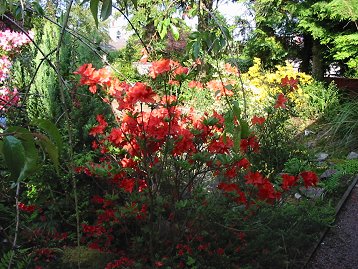
Our first look at gorgeous azaleas in the front yard of Mrs Gordon's B&B. A pleasant first night in Scotland in the higher part of Inverness.
June 8
We drive south along Loch Ness just like last year. Only one enormous difference - this time we can see the lake. And the gorse alongside the lake was a wonderful surprise. We had expected to see rhododendrons, but we had not been told about the overwhelming masses of gorse and broom.
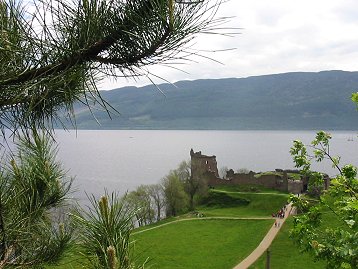
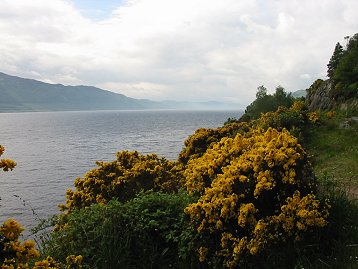
We stopped to take a look at the picturesque ruins of Urquhart castle, which we saw in pouring rain last year.
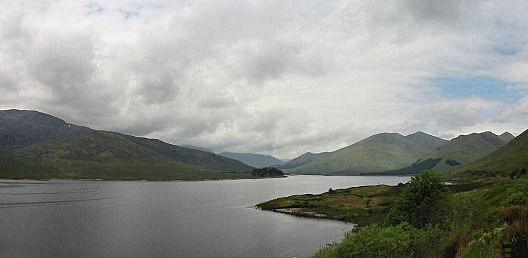
A small panorama of mysterious Loch Ness, but no monster visible this year either.
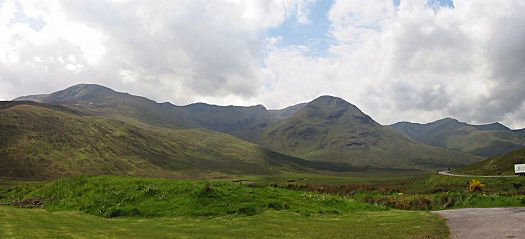
We drive through the green green hillsides of Glen Shiel after turning west
from Loch Ness on our way to Plockton.
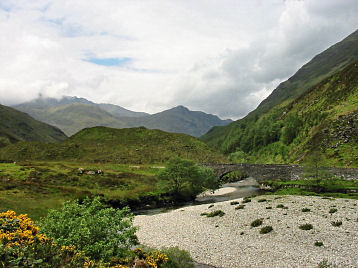
A charming old bridge that we drove past
on our way through Glen Shiel
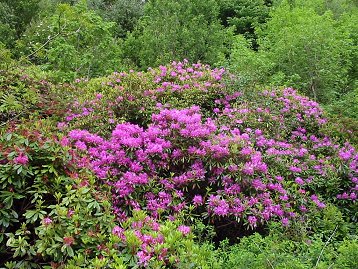
Glorious wild rhododendrons on the side of the road
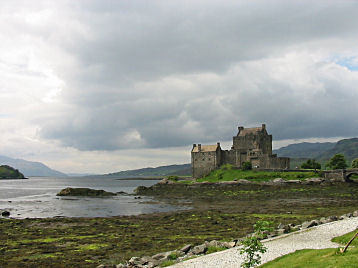
We drove by our second castle from last year, Eilean Donan, which had a
wonderfully reconstructed interior, with wax figures as working people
busy doing their various chores. This year we didn't stop, just admired
the beautiful setting on Loch Duich on our way to Plockton.
June 9
From Plockton to Elgol to Portree - quite a day!
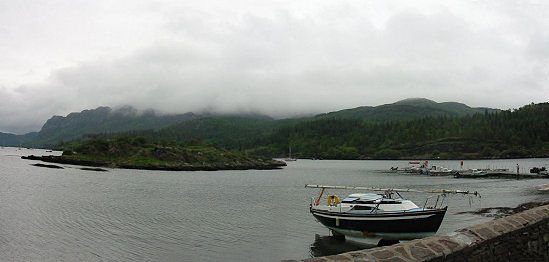 |
Plockton on the cloudy morning before we left for the bridge at Kyle of Lochalsh that takes you over to Skye. |
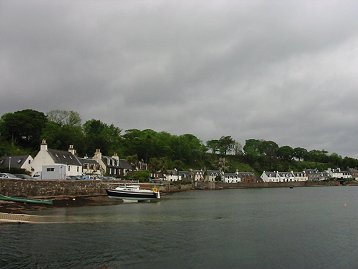 |
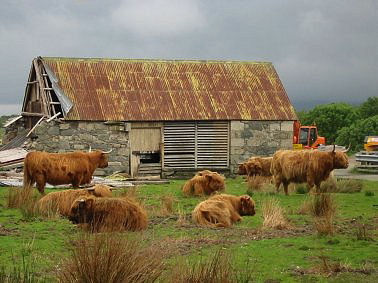 |
| The town of Plockton in a different kind of weather from last year. | We cut across the peninsula on a one-lane road on our way to the bridge at Kyle of Lochalsh. On the way we meet the highland longhorns, our friends from last year |
The Isle of Skye
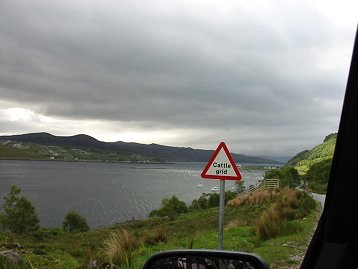 |
| After getting to Skye, our first real goal this year, across the bridge at Kyle of Lochalsh. We stopped at Broadford to get some information from a tourist office and just happened to see a poster for the boat trip from Elgol to the Black Cuillins and at the last minute we decided to go and find out about this. It was extraordinarily fortunate and it turned out to be a beautiful outing. We drove on a tiny road for 14 km, down to Elgol at the southern end of Skye. It was not a very promising-looking day as we drove south along the Loch Slapin to get to Elgol and the Cuillin Hills. On those one-lane roads you frequently get to road signs announcing Cattle grid ahead. Those are noisy metal bars that are there to keep the cattle from going out of bounds and which make a clangy noise as you drive across. There are also frequent passing places which are essential for getting by a meeting car. People are wonderfully courteous about this little constraint to road hogging and you always get a little hand gesture as thanks for the courtesy. Also, blinking headlights mean 'Go ahead, I am waiting for you.' Very civilized. |
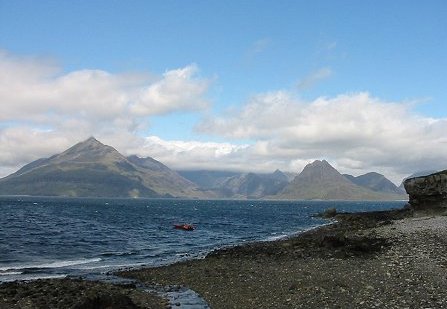 |
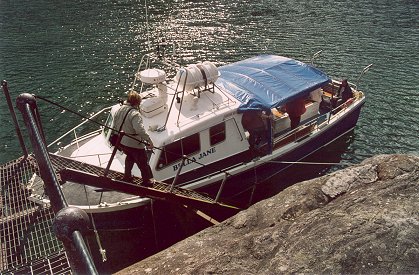 |
| From the small harbor we were going to take a boat, Bella Jane, to the northern point of Loch Scavaig, the bay west of Elgol. On the right is a view from the waterfront next to the harbor before we set out on the boat trip. |
And
here is Bella Jane and Siv stepping on board.
From the site of Bella Jane:
"Climb aboard the award winning Bella Jane - Scotland's first and only
5
Star Boat Trip (2005 assessment pending). Let us transport you to one
of Scotland's most isolated and breathtaking lochs - Loch Coruisk."
We highly recommend this trip, friendly, interesting and offering a good mini-hike with impressive scenery. |
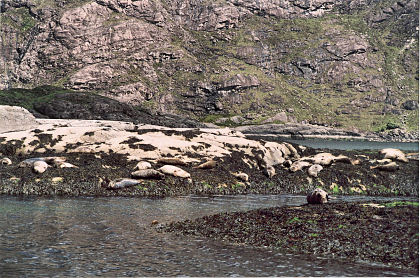 |
The
skipper took a side trip to let us see the huge number of seals on the
flat islands off the bay Loch Scavaig which we crossed to get to Loch Coruisk and the Black Cuillins. |
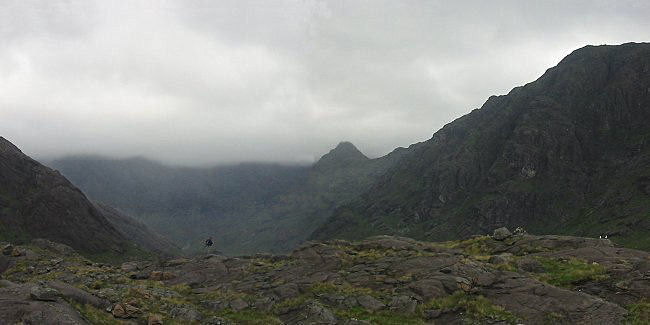
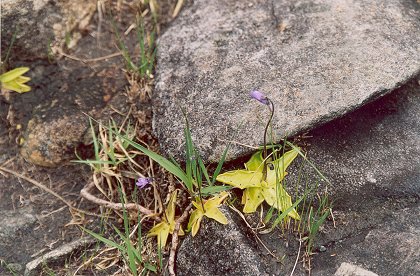
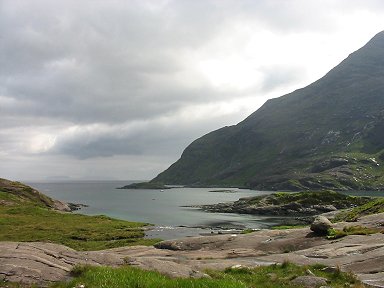
There were oodles of milkwort ('tätört' in Swedish) among the flat rocks that abounded alongside the loch. Those plants are (or maybe 'were') used in Lapland by the Sami people to make curdled milk.
There were a few drops of rain, but we had a sunnier view on our way back to the boat that was at anchor in the bay. Above you see what is approximately the inlet at Loch Coruisk of the shortest river in Scotland.
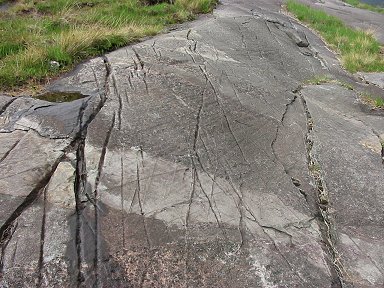 |
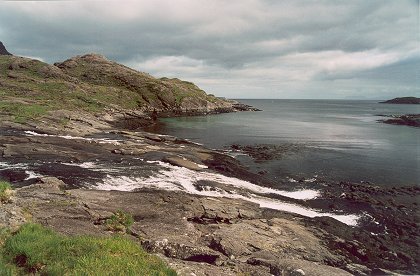 |
| Enormous amount of interesting striations on the more or less flat rocks alongside the loch. |
Here the short river, after about 100 meters, flows into the bay, Loch Scavaig, where Bella Jane lay anchored, waiting to take us back to Elgol. |
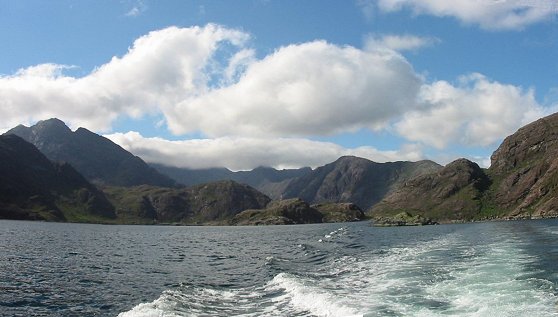
The weather has cleared up finally for our return trip to Elgol. Before starting back to Elgol, we were served tea or coffee with Scottish shortbread, which was a nice addition to the generally very friendly atmosphere on board.
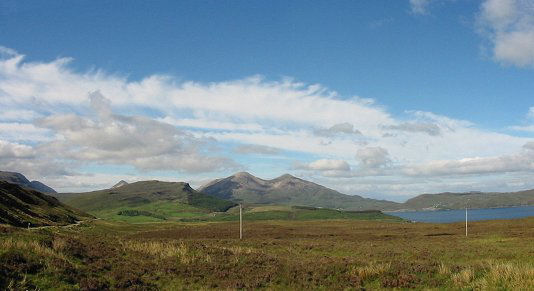
On our way to Portree via Broadford we drove by the Red Cuillins (to the right), which were quite a contrast to the stark Black Cuillins we had just seen at Loch Coruisk.
We arrived in Portree that evening where we were going to spend three nights at An Acarsaid B&B. Our host was wonderfully chatty and knowledgeable Charlie, who also prepared and served the most wonderful Scottish breakfasts we have ever had. It was here, for instance, that we learned to appreciate Stornoway black pudding! (Yes, Siv too - black pudding is approximately what we Swedes call blood sausage!)
June 10
First a brief visit to the harbor of Portree
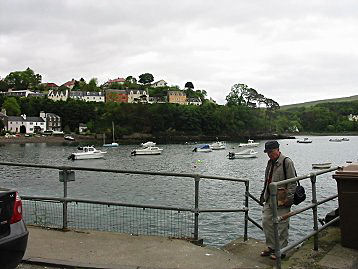
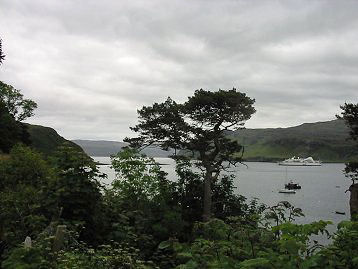
John down at the harbor in Portree.
On the right a view of the outer part of the harbor with the Island of Raasay in the background
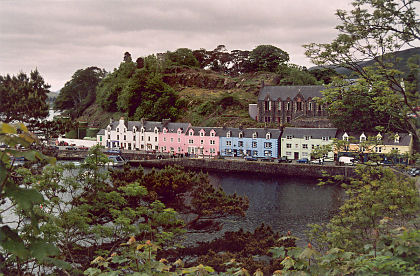 |
View from up the hill above the harbor, towards the extremely well kept houses in varied pastel colors. |
Then we set out on the day's big event, the Old Man
of
Storr, which we first see from far off, in silhouette against the sky.
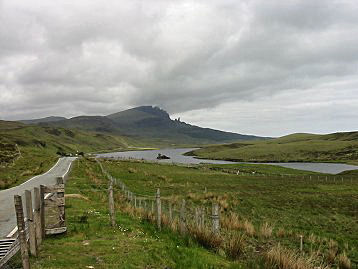 |
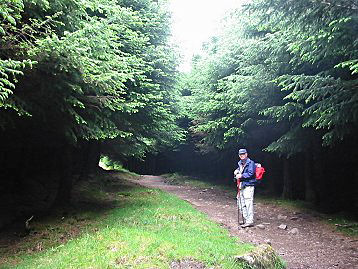 |
| Our first view of the Old Man outlined against the horizon on top of the hillside. | We are setting out on a pretty long hike, starting out with a walk through the woods. Lots of midges, so prepararation against those nasty little beasties was essential. |
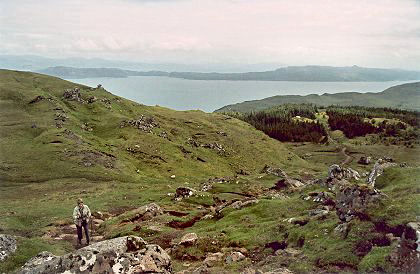 |
| Here we are getting pretty high up above the edge of the forest which can be seen in the back of the picture - getting close to the Old Man now. |
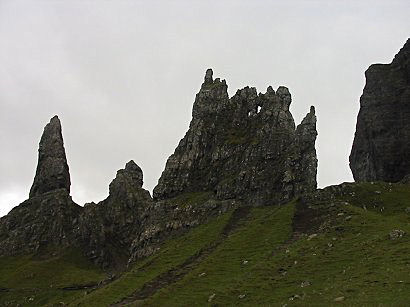 |
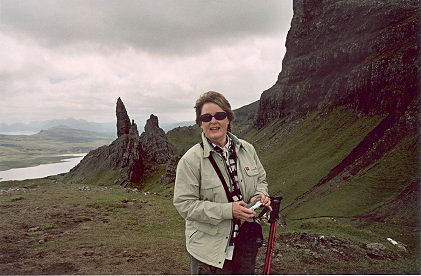 |
| The Old Man of Storr is rising up most impressively above us. We are deliberating whether to walk up closer or past and onwards. | Siv
is at the beginning of the last climb up the small hill where we get a
wonderful view of the Old Man and the coastline in the background. |
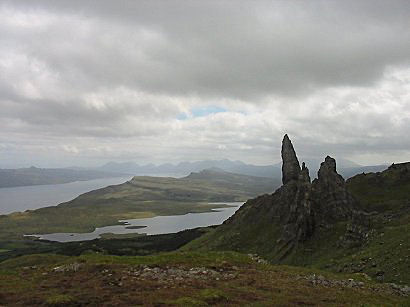 |
| We are up on the hill behind the Old Man of Storr - quite a climb from the woods down below and a wonderful view of the giant rocks and the hillsides, the sea behind and the Island of Raasay to the east of the Isle of Skye. |
June 11
A drive west, first to visit the ancient dwelling of Dun Beag.

After a visit, which was a guided tour, of the Talisker Distillery, we drove south to Glen Brittle, mainly wanting to see the Black Cuillins from the back. We did buy, after the tour, a 10-year-old bottle of Tallisker Scotch, only to find it in our supermarket at home in our Lyon suburb, at a somewhat lower price!
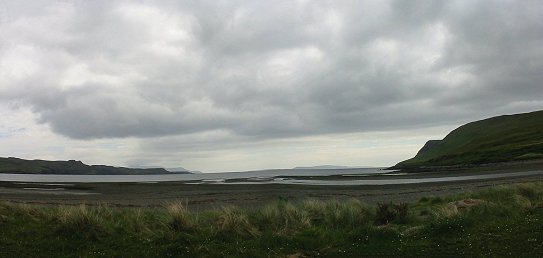
A view over Loch Brittle, the Cuillins out of sight on the left.
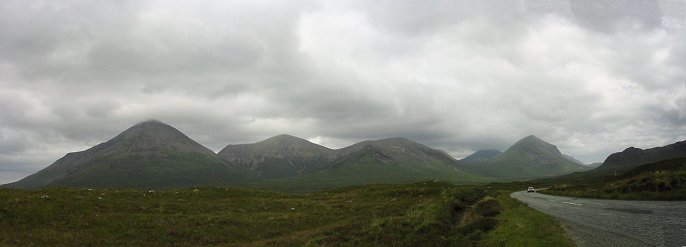
The Black Cuillins seen from the back as we return from Glen Brittle
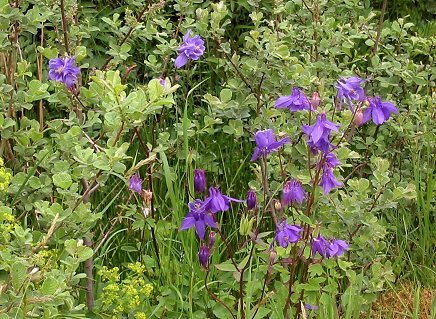
Wild columbines by the roadside coming back from the Cuillins. They are less purple,
lighter colored than the ones we are used to in the low-lying forests in the Alps.
A drive west, first to visit the ancient dwelling of Dun Beag.
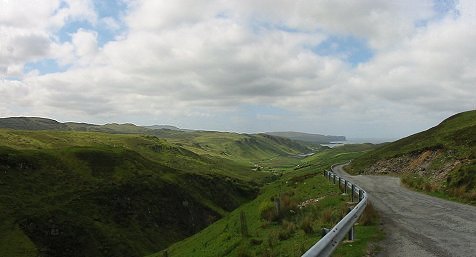 |
| On this scenic road leading to Dun Beag we were amazed at the absence of cars - and of billboards! We did not see one billboard on the whole trip, not this year and not last year. What a paradise! We left Portree in the midst of a beginning Marathon and here we are approaching the western side of the Isle of Skye. We knew before the marathon had started who was going to be the winner. We had seen him running up the 400 m climb to The Old Man of Storr on the previous day! |
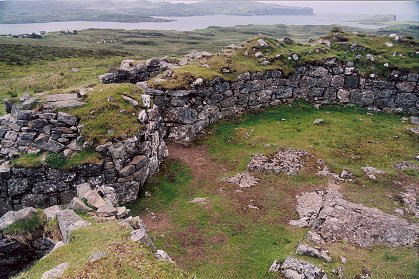 |
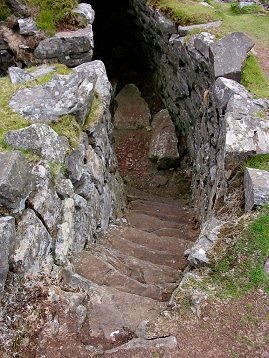 |
| A part of Dun Beag iron-age Broch at Struan. "The remains of the broch of Dun Beag lie on the west coast of Skye. In relatively good condition, the walls of this broch still stand up to 16 feet high." |
"...that wonderful stairway in Dun Beag, displaying the skilled construction by the ancient builders."
|

Peaceful view of the sea taken from Dun Beag over Loch Bracadale on the west coast of Skye.
After a visit, which was a guided tour, of the Talisker Distillery, we drove south to Glen Brittle, mainly wanting to see the Black Cuillins from the back. We did buy, after the tour, a 10-year-old bottle of Tallisker Scotch, only to find it in our supermarket at home in our Lyon suburb, at a somewhat lower price!

A view over Loch Brittle, the Cuillins out of sight on the left.

The Black Cuillins seen from the back as we return from Glen Brittle

Wild columbines by the roadside coming back from the Cuillins. They are less purple,
lighter colored than the ones we are used to in the low-lying forests in the Alps.